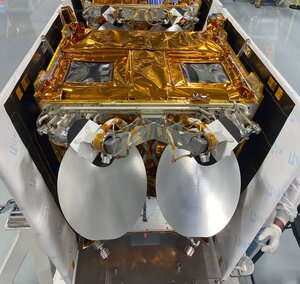Sinking boats raise automatic alarm up to space
At best, a yachtsman far out to sea experiences an exhilarating solitude to equal any space traveller. But too much isolation at sea can give rise to loneliness, disorientation and multiple dangers.
A new ESA-developed technology enables boat crews to check their positions, stay in constant contact with shore, receive urgent emergency warnings, and enable friends and family to remotely track them on the internet.
If a boat becomes dangerously water-logged or its power system is on the verge of failure, an onboard GlobalWave MT2000 terminal can send an automatic SOS message together with its exact GPS co-ordinates back to dry land, via satellites orbiting 35,000 km above the ocean waves.
Less dramatically, a yachtsman can also use his satellite terminal to book engineering or concierge service before he puts into shore. And even if his vessel is laid up for the winter the service remains useful – satellite-linked security sensors keep guard against intrusion.
Boat accessories company Volvo Penta has begun making this two-way communications service available to yachtsmen. It utilises a pre-existing satellite network called GlobalWave, operated by Canadian-based firm Vistar Telecommunications.

The GlobalWave network has been operational since 1999, employing geostationary satellites to give businesses the ability to remotely track and control assets such as trucks, storage tanks and construction equipment. End-users access data from GlobalWave with internet-linked servers.
As a boat represents probably the most expensive purchase someone makes after buying a home, extending GlobalWave to leisure and commercial boats seemed a good move, but a customized applications server would be required.
It was here that ESA (pledged to encourage research and development by European and Canadian industry) stepped in, signing a contract to develop a new application server with Vistar and perform pilot trials in a marine environment. The project commenced in July 2001, with marine trials starting in September that year.

ESA worked with a company called Navigation Research to fit five vessels with GlobalWave MT2000 terminals linked to bilge, voltage and intrusion sensors. These self-contained GPS-linked terminals are extremely energy-efficient, capable of functioning for a minimum of three years on battery power alone.
Ranging from a sailboat to a catamaran to a power cruiser to a trawler, these boats sailed along both coasts of the United States during the five month trial, one roaming as far as Hawaii. Users toured a number of boat shows during the trial, generating wide interest in the technology.
Trial feedback helped improve the services now offered by Volvo Penta, anticipated to rapidly become very popular. GlobalWave coverage was initially limited to the vicinity of the US but through regional operators the network is due to cover the globe by the end of this year.
"The GlobalWave Value-Added Application Server (GWVAS), developed by Vistar as part of the ARTES 3 programme element, provides a flexible and user friendly way to access the mobile GlobalWave terminals from a specific business entry point. The Marine Pilot phase run in the ARTES 3 project has been instrumental to demonstrate on the field the potential of the system." says Francesco Feliciani, Head of Applications Section in ESA.
Thanks to ESA, yachtsmen have the chance to sail secure, knowing they're making tracks through cyberspace as well as waves through the ocean.















 Germany
Germany
 Austria
Austria
 Belgium
Belgium
 Denmark
Denmark
 Spain
Spain
 Estonia
Estonia
 Finland
Finland
 France
France
 Greece
Greece
 Hungary
Hungary
 Ireland
Ireland
 Italy
Italy
 Luxembourg
Luxembourg
 Norway
Norway
 The Netherlands
The Netherlands
 Poland
Poland
 Portugal
Portugal
 Czechia
Czechia
 Romania
Romania
 United Kingdom
United Kingdom
 Slovenia
Slovenia
 Sweden
Sweden
 Switzerland
Switzerland


























